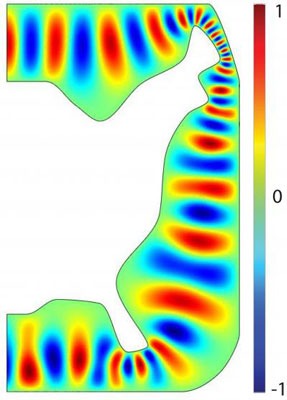| Posted: July 31, 2009 |
New metamaterial device steers light around corners |
|
(Nanowerk News) Using a composite metamaterial to deliver a complex set of instructions to a beam of light, Boston College physicists have created a device to guide electromagnetic waves around objects such as the corner of a building or the profile of the eastern seaboard.
|
 |
| Boston College researchers report developing a device that can bend light along complex pathways. An illustration shows a simulated electromagnetic wave propagation. Guided by a set of instructions delivered by the device, the wave curves around the profile of the eastern US while behaving as if traveling in a straight line.
|
|
As directed by the researchers' novel device, these beams continue to behave as if traveling in a straight line. In one computer simulation, Assistant Professor of Physics Willie J. Padilla and researcher Nathan Landy revealed the device could steer a beam of light along the boundary of the US, stretching from Michigan to Maine, down the seaboard, around Florida and into the Louisiana bayou, according to research published in the research journal Optics Express.
|
|
The researchers accomplished their feat by developing a much more precise set of instructions, which create a grid-like roadmap capable of twisting and turning a beam of light around objects or space. Their discovery is an extension of earlier metamaterial "cloaking" techniques, which have conjured up images of the Harry Potter character disappearing beneath his invisibility cloak.
|
|
Padilla and Landy report developing a space-mapping technique that delivers greater precision and efficiency guiding light along pathways that previously were too complex to sustain – from 90-degree angles to the rugged coastal profile of Maine. Furthermore, they've built this new device using relatively common dielectric materials, such as silicon.
|
|
|
|
"Our method combines the novel effects of transformational optics with the practicality of dielectric construction," Padilla and Landy report. "We show that our structures are capable of guiding light in an almost arbitrary fashion over an unprecedented range of frequencies."
|
|
The discovery builds upon a decade-long revolution in electromagnetics brought about by the emergence of metamaterials. Constructed from artificial composites, metamaterials have exhibited effects such as directing light at a negative index of refraction.
|
|
Researchers have combined metamaterials with artificial optical devices – also known as transformational optics – to demonstrate the "invisibility cloak" effect, essentially directing light around a space and effectively masking its existence. In addition, other researchers have used a method known as quasi-conformal mapping and very complex metamaterials to issue a somewhat imprecise set of instructions that create another space-cloaking effect.
|

